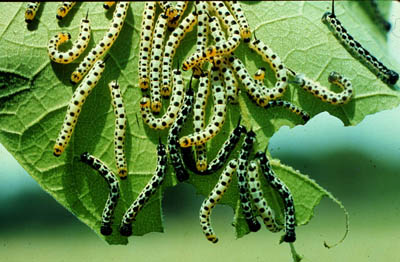

Purpose:
Students will see the way the caterpillars can hang onto the leaves using their specially adapted “feet” that work like suckers called prolegs. The Catalpa has three pairs of these legs. They will also have to decide where on the tree is the best place to put the caterpillars to avoid predation. Students will learn that organisms need energy from food or the tree and the tree is a source of shelter also. The concept of a food web can be introduced.
Step One:
Allow students to suggest where the best place to put the caterpillars will be and why they think this is true. The teacher should ask the student or explain to students about the idea of predation. Students can be asked to name examples of animals that eat other animals and why they have to do this to survive. Teachers should introduce the idea of a food web.
Step Two:
Students should label the trees with numbers using surveyor's flagging tape and make each group of caterpillars on a particular tree correspond to that number. An equal number of caterpillars should be placed on each tree and always returned to the same tree to increase control. Teachers can introduce this concept . Students or the teacher could draw a layout of trees and their numbers. Students could even do this to scale and learn to measure or use spacing. Trees should be described and the number of leaves estimated. Students can take pictures of the trees each time and see how defoliation occurs and observe the caterpillars feeding.
Step Three:
Students and teacher can place caterpillars on the trees making notes how many are placed on top of leaf, on bottom or on the trunk for each tree. Teachers should make sure that a number are definitely placed on the bottom of the leaf since this is how they naturally find protection.
Step Four:
Students will once a week observe the caterpillars on the tree listing the number that are on top or under leaves or on the trunk for each tree as well as total number. Students will compare these observations with the initial placement observations. Students should be asked to make inferences about their observations and try to explain why they occurred. Student can be asked to predict what the next week’s observations will be and record this in their logs along with the data.
Step Five:
Students use numbered containers for collecting caterpillars and then use them for their observations in Lesson Plan 6 which is ongoing. After their measurements for Lesson Plan 6, students will return them to the trees making sure to replace them according to the observed numbers: on top or below the leaf & trunk.
Suggestions:
For younger students the chart can be made into a larger one and the number of cateperillars represented by cut outs of caterpillars. This would work well with a felt board but could be done with stickers or glue.

| Discover Life | Education | Training Guides and Protocol s | The Catapillar's Habitat |